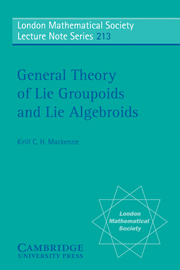Book contents
- Frontmatter
- Contents
- Prologue
- Introduction
- Preface
- TERMINOLOGY AND NOTATION
- ACKNOWLEDGEMENTS
- PART ONE THE GENERAL THEORY
- PART TWO THE TRANSITIVE THEORY
- PART THREE THE POISSON AND SYMPLECTIC THEORIES
- 9 Double Vector Bundles
- 10 Poisson Structures and Lie Algebroids
- 11 Poisson and Symplecfie Groupoids
- 12 Lie Bialgebroids
- Appendix
- Bibliography
- Index
10 - Poisson Structures and Lie Algebroids
from PART THREE - THE POISSON AND SYMPLECTIC THEORIES
Published online by Cambridge University Press: 05 April 2013
- Frontmatter
- Contents
- Prologue
- Introduction
- Preface
- TERMINOLOGY AND NOTATION
- ACKNOWLEDGEMENTS
- PART ONE THE GENERAL THEORY
- PART TWO THE TRANSITIVE THEORY
- PART THREE THE POISSON AND SYMPLECTIC THEORIES
- 9 Double Vector Bundles
- 10 Poisson Structures and Lie Algebroids
- 11 Poisson and Symplecfie Groupoids
- 12 Lie Bialgebroids
- Appendix
- Bibliography
- Index
Summary
Poisson geometry has developed from three principal sources: it is a more natural and convenient framework for many of the basic constructions and ideas of symplectic geometry; it embodies a theory dual to Lie algebra theory; and it is a semi–classical limit of modern quantum geometry.
Associated with any symplectic manifold (M, ω) is the Poisson bracket {u, v} = ω(Xu, Xv) = Xu(v) of functions on M, where Xu is the Hamiltonian vector field for u; this bracket makes C∞(M) a real Lie algebra and in each variable it is of course a derivation of the algebra structure on C∞(M). Furthermore, the symplectic structure can easily be recovered from the Poisson bracket. An abstract Poisson manifold is a manifold M equipped with a bracket of smooth functions which satisfies these two properties (see 10.1.1). Certain crucial constructions in symplectic geometry — most notably reduction — proceed more naturally if one works with the Poisson bracket rather than with the symplectic form, and have Poisson formulations from which the classical symplectic results can be retrieved easily.
The other fundamental example of a Poisson manifold is the vector space dual of a Lie algebra. The bracket on g induces a Poisson bracket on the smooth functions on M = g* (see 10.3.7) which is linear in the sense that the Poisson bracket of two linear functions is linear. These linear Poisson manifolds are in an exact duality with Lie algebras, and one may work entirely in terms of these duals rather than in terms of the Lie algebras.
- Type
- Chapter
- Information
- General Theory of Lie Groupoids and Lie Algebroids , pp. 380 - 407Publisher: Cambridge University PressPrint publication year: 2005

